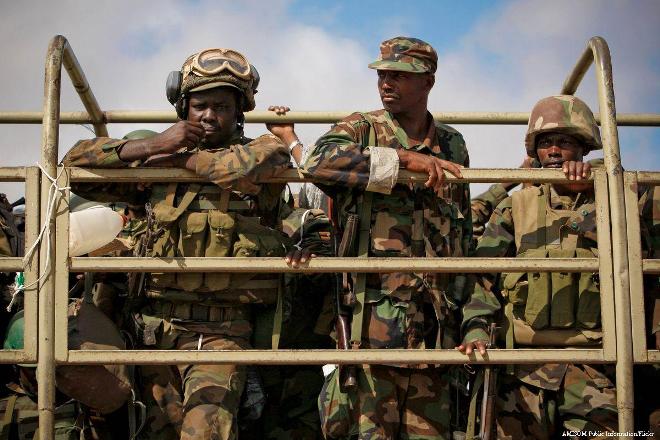
Abdi Adan
Tuesday November 21, 2017

AMISOM & Somali National Army troops [AMISOM Public Information/Flickr]
If its current timetable isn’t revised, by December 2020, AMISOM combat troops are scheduled to withdraw from all of Somalia’s cities, towns and villages that they’ve liberated from the Al-Shabaab terrorist organisation. The troops have been in Somalia for over a decade to support the Federal Government of Somalia against radical elements of Al-Shabaab who continue their insurgency against the Federal Government of Somalia’s institutional and military presence in Somalia.
AMISOM is comprised of troops drawn from Uganda, Ethiopia, Djibouti, Kenya and Burundi deployed in six sectors covering south and central Somalia through funding support from the EU and UN.
The troops, alongside the Somali National Army (SNA), remain the main source of protection for the government as they patrol major roads connecting the Somali capital to other regions and managed to liberate significant cities such as Mogadishu, Kisimayo, Beledweyne and Baidoa.
Though the African Union mission didn’t fully pacify the country as required and expected, it deserves applause for creating an enabling environment for the Somali government to re-organise and prioritise its resources and establish a national army to build on the current progress in liberating the remaining areas still under Al-Shabaab’s control.
Somalia: Al-Shabaab retakes key town from African Union troops
The effects in the reduction of AMISOM troops have already been felt in different parts of Somalia in spite of Special Representative of the African Union Chairperson for Somalia, Francisco Madeira, stating that the transition would be gradual, conditions-based, responsible and done in a manner that will not compromise the safety and security of the Somali people.
Somalia’s readiness for a takeover
Besides their military operations against Al-Shabaab, the AMISOM troops have been training and equipping the Somali National Army (SNA) with the objective of gradually handing over security duties in liberated areas to the SNA.
After close to 18 months of successful operations that uprooted Al-Shabaab’s control over major cities, by mid-2013 the offensives by AMISOM and the SNA came to a halt. Neither AMISOM nor the Somali army had the capacity to push beyond areas already recovered and their hold on the existing territory would be tenuous if the current status quo continued.
In recent years, a range of external actors have played a role in training the SNA. These include the European Union, Turkey, the United Arab Emirates, the US and a private security company, Bancroft Global. Although their help has been valuable, the lack of consistency and proper coordination in the different training techniques was a challenge for the SNA.
The Somali military significantly lacks proper equipment and coordinated training that will inculcate it with same military discipline, national ownership and patriotism to liberate its country from extremists.
As currently constituted, the SNA is more of a collection of regional clan militias than a unified national force that can take over security tasks from AMISOM.
Somalia’s stability primarily relies on its own military and police forces to secure their own territory. That prospect, however, seemed to be a long way off until recently when the Turkish government opened a $50 million military training facility in Mogadishu capable of accommodating the training of 1,500 forces at the same time with the presence of more than 200 Turkish military trainers. This, it is hoped, will help in the reconstruction of a strong Somali national force that can tackle the threat of Al-Shabaab after the withdrawal of AMISOM forces.
Al-Shabaab attack military base near Mogadishu
Somalia is still under a partial UN arms embargo that prevents it from importing heavy weaponry while allowing it to import light weapons for its security forces. This embargo is a major setback for the government to be really “self-sufficient” in terms of military offensives to confront Al-Shabaab.
Al-Shabaab’s capability to re-emerge
While AMISOM/SNA troops mainly focused on liberating major cities and headquarters of regional administrations, the Al-Shabaab extremists were taking advantage of the relative freedom they had in the vast Somali countryside to regroup, plan and execute attacks against civilians.
The group has recently demonstrated its ability to conduct numerous complex raids against hard AMISOM targets, causing significant casualties. Its ability to conduct attacks which resulted in mass-casualties in the capital Mogadishu and sustained small-arms attacks against Somali government and security officials is yet to be contained.
The recent bloody bombings in Mogadishu which injured and claimed the lives of more than 400 people are an indicator that the extremist group is still active and capable of re-emerging in the event that a military vacuum arises in the country.
The failure of AMISOM and Somali National Army to pursue Al-Shabaab into the hinterlands because of constraints – or perhaps even a lack of political will – has provided Al-Shabaab the ability to maintain access to financial resources, recruitment and training of new foot soldiers, and a space to operate relatively freely outside of major populated centres.
Aftermath of Somalia’s 9/11 counter-terrorism quandary
Al-Shabaab has exploited shifts in the AMISOM force posture to prepare for its counteroffensive. When the Ethiopian contingent of AMISOM pulled back in early 2017, Al-Shabaab immediately reentered numerous towns across the country. The ease with which Al-Shabaab flipped the towns shows that it had retained a presence nearby and that other territory could be as susceptible to an Al-Shabaab re-conquest.
With the presence of AMISOM forces, Al-Shabaab’s disastrous presence has not been isolated to Somalia only; the group has expanded its area of operations into northern and coastal Kenya and demonstrated its capability to hit targets outside Somalia. It is poised to exploit the region’s religious and security conditions.
Who knows what will happen over the next 25 months as AMISOM troops steadily withdraw lowering their profile to the vanishing point. Somalia might revisit its anarchic history, or President Farmajo might manage to clench onto control and wipe out Al-Shabaab before the last batch of AMISOM troops withdraws from the country.